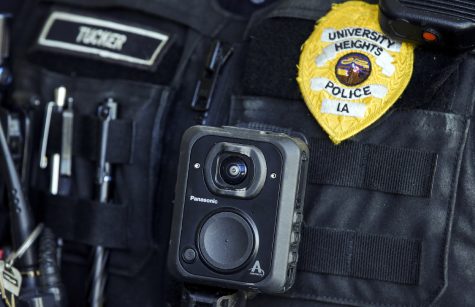In Focus | Iowa police body camera video sometimes revealing — if the public is allowed to see it
Victims and reporters often have to go to court to gain access.
University of Iowa Police Officer Alton Poole wears his VIEVU LE2 Body Worn Video Camera as he patrols the Finkbine Golf Course tailgating lot before Iowa’s game against Northern Iowa Saturday, Sept. 15, 2012 in Iowa City. The University of Iowa has outfitted all 43 of their police officers and 18 members of their security staff with the cameras at a cost of $899 each.
February 1, 2021
Editor’s Note: This article is the first in an occasional series called “In Focus” about public access to police body camera and in-car camera video in Iowa.
By Erin Jordan, The Gazette, and Jared Strong, Carroll Times Herald
When an Iowa City police officer in 1996 accidentally shot and killed Eric Shaw, an artist working late in his father’s office, Troy Kelsay wasn’t the one who fired the gun but knew police had made a terrible mistake when he saw blood flow from Shaw’s body.
“Then, the standard practice was for police departments to say ‘no comment,’” said Kelsay, who, after 27 years in the Iowa City Police Department, is chief in University Heights, an enclave of about 1,100 tucked within Iowa City.
“The PD and city, wrongly I think, were saying ‘no comment.’ Saying ‘we screwed up’ wasn’t going to change anything, but you’re far better off saying ‘I f’ed up royally. What can I do to deal with the here and now? And what can I do in the future so this doesn’t happen again?’”
That experience made Kelsay strive to be as open as possible with the community, whether that means answering to a citizens’ review board or releasing body camera video to the public.
University Heights allows the public, including news reporters, to review video from police body cameras or in-car cameras according to Iowa Code Chapter 22, Iowa’s open records law, with permission of the chief or other authorized employee.
But not every law enforcement agency across Iowa has the same policy. Some departments say police video should be released to the public only if it “serves the interest” of the agency. Others make no mention of the video as a public record, although according to Iowa law, it is.
A decade after Iowa law enforcement agencies started using body cameras, Iowa has a widely divergent, unregulated system of rules and policies governing public access to a tool that many saw at the outset as a way of monitoring the conduct of police. Those disparities, found in a review of the policies of more than 200 agencies, can endanger the ability of everyday Iowans to answer questions about a family member’s death at the hands of police or prove their innocence.

For instance:
- Autumn Steele, a mother, was accidentally shot and killed in 2015 by a Burlington police officer while standing in her yard with her child. Video footage and other records released by order of a federal judge in a $2 million wrongful death lawsuit shows what the family says was a police effort to cherry pick information and witness statements to blunt police liability.
- Isaiah Hayes, a man from Wisconsin, was fatally shot in 2018 by a Polk County sheriff’s deputy. The office agreed in 2019 to release footage of the incident after a 15-month legal battle that cost taxpayers $120,000 to the Iowa Freedom of Information Council, which sued for release of the records.
Editor’s Note: A previous version of this story detailing the use of police body camera policies across Iowa incorrectly identified the race of Isaiah Hayes, a man from Wisconsin fatally shot by a Polk County Sheriff’s Deputy in 2018. The Polk County sheriff’s report identifies him as Caucasian, not of Hispanic origin.
- Drew Edwards, 22, died in June 2019 after being Tasered by Maquoketa police. The city didn’t release the body camera video for months — even after the case was closed — citing protection of Edwards’s privacy. But it was Edwards’s family that wanted the video. The family eventually won a $4.5 million wrongful death settlement.
Members of the Iowa Newspaper Association, including The Daily Iowan, requested and received video policies from more than 200 law enforcement agencies for this report, which examines how police are using body cameras, how easy it is to access police video and what ideas Iowans have for balancing privacy and accountability.
Cameras change police work
Iowa law enforcement agencies started using cameras decades ago to record interactions with the public, but the use has evolved as technology has changed.
When Carroll County Sheriff Ken Pingrey was hired to be a deputy about 20 years ago in western Iowa, his patrol vehicle had a handheld camcorder mounted to its dash. He’d spent the first 10 years of his career without cameras, and it was sometimes difficult to remember to hit the record button for traffic stops.
“When I first started, you had radio in your car, a radar unit and a lightbar controller,” Pingrey said. “Now there are printers, computers, cameras, all the other stuff.”
The Carroll County office later upgraded to new systems that included a metal storage box in the trunk that held a large tape recorder that started automatically when the red-and-blue lights were activated.
Around that time in Iowa City, Alton Poole started fiddling with smaller cameras and tried to affix one to his University of Iowa police uniform. He had watched the dashcam recording of a state trooper in a scuffle with someone who tried to grab the trooper’s gun. The problem with the video was that the reach for the gun happened outside of the camera’s view.
“Made it very easy for the public to jump to conclusions,” Poole recalled. “After seeing that, I thought: ‘Why aren’t we equipping our person with cameras?’”
Poole said his department was the first in the state and one of the first in the nation to equip all of its officers with body-worn cameras, which happened in 2011.
Of more than 200 agencies that responded to a request from Iowa media outlets, 90 percent now use body cameras. At $600 to $900 per camera, not to mention computer servers that can cost up to $500,000, cost is the limiting factor.
Deterring bad behavior
These expensive tools have changed law enforcement — in part by deterring bad behavior on both sides of the camera, officers said.
Poole likes to tell a story about asking a tailgater with an open container to empty his beer can.
“He asked, ‘What if I told you I was an attorney?’” Poole recalled. “I responded, ‘What if I told you I was recording this conversation for the judge?’ Then the attorney poured out his drink.”
Appanoose County Sheriff Gary Anderson recently responded to a complaint against one of his officers by reviewing the body camera video and seeing that the complainant’s third-hand account was mistaken.
“If someone comes in here and wants to make a complaint, sit down here and watch the video with me,” said Anderson, who has been at the southern Iowa agency for 34 years, 21 as sheriff. “I have nothing to hide.”
Body cameras also can help law enforcement supervisors detect and address misconduct among cops, said Sgt. Paul Parizek, public information officer for the Des Moines Police Department.
In 2019, Des Moines police Chief Dana Wingert fired Officer Lourdes Hadenfeldt after her body camera video showed she lied about what happened during a traffic stop. Hadenfeldt said a driver struck the officer’s arm with her car’s side mirror, but the video showed otherwise.
Other examples have come up in hearings for officers seeking unemployment benefits after being fired:
- In 2019, Muscatine Officer Benjamin Valera punched a handcuffed woman in the face, which knocked her to the ground, records show. The incident was captured on body camera video — then more widely circulated when the officer used his cellphone to make a recording of it, which he showed to other officers, emergency dispatchers and his father.
- In a 2018 traffic stop, Adam Olson, a North Liberty police sergeant, failed to do pat-down searches of three people suspected of shooting out the window of a vehicle, an administrative law judge found. A fellow officer who examined the video found Olson had committed more than a dozen policy violations during the stop.
‘If there’s no video, it didn’t happen’
Bodycam video and witness cellphone video have streamlined prosecution of criminal cases in Butler County, said Greg Lievens, who recently retired after 32 years as county attorney. Video reduces the number of depositions before trial and answers questions for defense attorneys, he said.
Now that body cameras are the norm, prosecutors, defense attorneys and residents expect video of every police interaction. And they expect to be able to see everything — like they would with a TV crew filming an episode of “CSI.”
“Jurors sit there and they watch a 30-minute television show and they expect lasers, they expect three-dimensional animation, they expect to watch the crime being recreated right in front of them,” said Black Hawk County Sheriff Tony Thompson, who is president of the Iowa State Sheriffs and Deputies Association. “There are cases where a prosecutor has been unwilling to prosecute the case because a bodycam failed.”
Poole agreed, saying: “When you have a jury trial, one of the first things they ask is, ‘Where’s the video?’ If there’s no video, it didn’t happen.”
Policies widely inconsistent
Most agencies have written policies for officers using body-worn cameras and in-car cameras, although a dozen sheriffs and police chiefs noted their policies were outdated — some still mention VHS tapes — and said new versions are in the works.
The word “policy” is used loosely by some agencies. The Ackley Police Department, a four-officer agency in Hardin County, has a two-paragraph memo from Sept. 24, 2019, that includes the directive “You are all professionals, so use your judgment when to use them …”
The policies run the gamut in amount of time to save the recordings, ranging from as little as a week to indefinitely. In Forest City, police video of a traffic stop “in which there is no known arrest or other known reason to place the video into evidence” may be deleted in seven days.
The Jones County Sheriff’s Office’s policy says “system files of non-evidentiary value are maintained for a minimum of 30 days and (then) classified as junk.”
But sometimes the public may not request a video of an interaction with police until later.
“If someone is pulled over for a traffic stop they feel is not proper, they’ve got a way to take a look at it,” said Pete McRoberts, ACLU of Iowa policy director, about body camera footage. “People can be honest, but still wrong, about what they recall. A bodycam can break the tie.”
Video from bodycams or in-car cameras often is useful for training and can help officers learn how to avoid acting on an implicit bias, McRoberts said.
Neither the State Sheriffs and Deputies Association nor the State Police Association provides policy recommendations, and the Iowa Law Enforcement Academy does not train recruits on how to use body cameras because of the different technologies
Can the public see Police videos?
Nearly half the Iowa police policies reviewed identified video as a public record, either by mentioning Iowa Code Chapter 22 or stating media would be allowed to view video in at least some circumstances.
But many chiefs and sheriffs have declined to release video, even in closed cases and even when the person shown in the video wants it to be made public.
“There shouldn’t be any issue of when they (videos) should be released,” said David O’Brien, a Cedar Rapids lawyer who represented the family of Autumn Steele, and, more recently, is using body camera video in a wrongful-death lawsuit filed against the Burlington police who fatally shot Marquis Jones in 2017.
“How can you argue a body camera isn’t immediate facts and circumstances?” O’Brien asked, referring to language in the Chapter 22 open records law that requires law enforcement officers to release the “immediate facts and circumstances” of criminal cases unless they could jeopardize an investigation or put people at risk. “I think they should be released immediately. The law is pretty clear on it.”
Anderson, from Appanoose County, would like to have an open conversation with law enforcement, media and privacy advocacy groups like the ACLU about when video is released.
“There needs to be some discussion made, but not demands from people,” Anderson said. “Do we need to re-abuse a female, a child or whoever with a video that’s going to be coming out? That has some long-term mental health ramifications.”
The ACLU seeks to protect the privacy of people inadvertently shown on camera or people in their own homes who aren’t part of a police investigation.
“Once someone is part of a public investigation, arrest or stop, that becomes a public record,” McRoberts said.
Each Iowa department makes its own rules
More than half of U.S. states have a law that addresses release of body camera video, the Reporters Committee for Freedom of the Press reported.
The law in Minnesota, where George Floyd was killed last spring in the custody of the Minneapolis Police Department, says recordings become public if they show the discharge of a firearm or use of force by an officer that results in “substantial bodily harm.” The other exception is if the person shown in the video wants it to be public.
Missouri’s law, passed in 2016, allows police videos to remain secret until after a criminal case is closed or if the video was shot in a private location. The exception to the last part is if the person shown in the recording wants the video.
Gunita Singh, legal fellow with the Reporters Committee, said states don’t necessarily need a law on body cameras, but policymakers need to make sure laws reflect changing technology.
“As technology continues to evolve, we need to broaden the scope of what constitutes a public record to which the public and press are entitled,” she said. “In Iowa, especially, the law has a presumption of disclosure. Laws governing body-worn cameras must strive to facilitate openness.”
Other ways to bring consistency
Cedar Rapids lawyer Sam Jones wants law enforcement agencies to adapt their policies in recognition of mounting court verdicts that require release of body camera video.
“It’s a bit of a bruising process, but ultimately this litigation is healthy,” he said. “There will be greater certainty as a result of it.”
In 2019, the Iowa Supreme Court ruled a lower court was correct to balance “confidentiality and transparency” in a decision to release records, including video, of the 2016 shooting by a white police officer of Jerime Mitchell, a Black Cedar Rapids man paralyzed by the shots.
In Polk County, a District Court judge in October ordered Parizek to pay a $100 civil penalty and for the department to pay the legal costs of a civil rights advocate who sued Parizek for not releasing body camera video from officers involved in a contentious 2018 arrest.
“The public has an interest in how police respond to calls for service,” Judge Paul Scott ruled Oct. 6. “Police departments are funded by the public and answer to the public.”
O’Brien, the Cedar Rapids lawyer, thinks the fines should be higher — maybe $100 a day — or officers should face possible simple misdemeanor charges for not releasing video.
This project is a collaboration of members of the Iowa Newspaper Association and includes reporting from 51 newspaper reporters across the state. Readers who have experienced difficulty obtaining police video in Iowa can contact reporters at [email protected]. Public records requests and data storage/visualization was supported by a grant from the Fund for Investigative Journalism.






